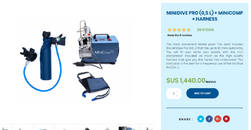Has anyone tried filling tanks with these compact $200 compressors that have shown up? There are a few out there, below is an example. One of them out there is labeled as "Kwasyo" brand (kwasi-who? ). Says it can fill up to 4500 PSI at 50L/minute. If I'm doing my math right, it seems like you could fill an 80 in about 45 minutes, but I could be WAY off on that. $200 seems like it would be pretty cheap for filling your tanks at home, but unsure if I'd be willing to take a chance on the filtration being good enough to keep hydraulic oil out of my lungs!

Here we are on page 3 and there still isn't a good reply, just a lot of OMG UR GOING TO DIE which isn't helpful in understanding the capabilities and limitations of these inexpensive products.
Producing high-pressure breathing air involves the use of two components: a pump and a filtration system. Typical SCUBA compressors sold by the major makers for the purpose of filling SCUBA cylinders have both of those components. They are both necessary. Let's take them one at a time.
Considering the pump alone, there are three problems with the inexpensive, low-speed paintball pumps sold on ebay and elsewhere, when used in a scuba application:
1) The output is low leading to excessive fill times (hours)
2) They are water cooled, requiring a constant source of clean, running water to avoid overheating
3) The useful life is typically fairly short, perhaps 100s of hours, which is OK for paintball fills into smaller cylinders but which does not provide an economical solution for SCUBA
Keep in mind that any high pressure air compressor is loud and requires some amount of monitoring while in operation. You would not, for example, want to run the thing in your apartment all day while you go to work.
Now, on the filtration side of things, the problem is that these pumps typically don't have any filtration or perhaps have some filtration for water only. You can add filtration, but realize that the filtration system is a significant share of the cost -- I have one in the classifieds right now that you can take a look at if you want an idea of the going rate. The main contaminants are water, carbon monoxide, and hydrocarbons. The water poses a corrosion problem and a freezing hazard, and the carbon monoxide and hydrocarbons are toxic. These contaminants are present in the incoming air as well as being produced as byproducts of the compression process due to the presence of heat and lubricating oil.
There's no way I'd ever use air for diving that hadn't been through a proper filtration system designed and maintained specifically for breathing air.





